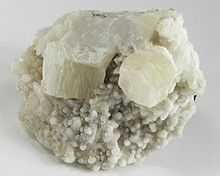Witherite
| Witherite | |
|---|---|
 Witherite from Cave-in-Rock (size: 4.9 x 3.7 x 3.2 cm) | |
| General | |
| Category | Carbonate mineral |
| Formula (repeating unit) | BaCO3 |
| Strunz classification | 05.AB.15 |
| Crystal symmetry | Orthorhombic dipyramidal (2/m 2/m 2/m) |
| Unit cell | a = 5.31 Å, b = 8.9 Å, c = 6.43 Å; Z = 4 |
| Identification | |
| Color | Colorless, white, pale gray, with possible tints of pale-yellow, pale-brown, or pale-green |
| Crystal habit |
Striated short prismatic crystals, also botryoidal to spherical, columnar fibrous, granular, massive. |
| Crystal system | Orthorhombic |
| Twinning | On {110}, universal |
| Cleavage | Distinct on {010} poor on on {110}, {012} |
| Fracture | Subconchoidal |
| Mohs scale hardness | 3.0 - 3.5 |
| Luster | Vitreous, resinous on fractures |
| Streak | White |
| Diaphaneity | Subtransparent to translucent |
| Specific gravity | 4.3 |
| Optical properties | Biaxial (-) |
| Refractive index | nα = 1.529 nβ = 1.676 nγ = 1.677 |
| Birefringence | δ = 0.148 |
| 2V angle | Measured: 16°, calculated: 8° |
| Dispersion | Weak |
| Ultraviolet fluorescence | Fluorescent and phosphorescent, short UV=bluish white, long UV=bluish white |
| References | [1][2][3] |
Witherite is a barium carbonate mineral, BaCO3, in the aragonite group.[1] Witherite crystallizes in the orthorhombic system and virtually always is twinned.[1] The mineral is colorless, milky-white, grey, pale-yellow, green, to pale-brown. The specific gravity is 4.3, which is high for a translucent mineral.[1] It fluoresces light blue under both long- and short-wave UV light, and is phosphorescent under short-wave UV light.[1]

Witherite forms in low-temperature hydrothermal environments. It is commonly associated with fluorite, celestine, galena, barite, calcite, and aragonite. Witherite occurrences include: Cave-in-Rock, Illinois, USA; Settlingstones Mine Northumberland; Alston Moor, Cumbria; Anglezarke, Lancashire and Burnhope,[4] County Durham, England; Thunder Bay area, Ontario, Canada, Germany, and Poland (Tarnowskie Góry and Tajno at Suwałki Region).
Witherite was named for William Withering (1741-1799) an English physician and naturalist who in 1784 published his research on the new mineral. He could show that barite and the new mineral were two different minerals.[3][5]
Risk to human health
The 18th-century naturalist Dr. Leigh recorded its lethal effects after the death of a farmer's wife and child. James Watt Jnr. experimented with the mineral on animals and he recorded the same lethal properties.[6] Until the 18th century farmers at Anglezarke used the mineral as rat poison.[7]
Industrial use
An experiment conducted by Josiah Wedgwood, led to it being used in his 'Jasper ware'; the mineral had previously been considered as worthless.[7] Witherite has been used for hardening steel, and for making cement, glass, enamelware, soap, dye and explosives. [8]
See also
References
- ↑ 1.0 1.1 1.2 1.3 1.4 Witherite mindat.org
- ↑ Handbook of Mineralogy
- ↑ 3.0 3.1 Webmineral data
- ↑ Ashburn, J.H., Mining Witherite in North-West Durham, Colliery Guardian, August 1963 (at Durham Mining Museum web-site)
- ↑ Withering, William (1784). "Experiments and Observations on Terra Poderosa". Philosophical Transactions of the Royal Society of London 74: 293–311.
- ↑ Watt, James Jr. (1789). Memoirs and Proceedings of the Manchester Philosophical Society. p. 598.
- ↑ 7.0 7.1 The Mining Magazine, March 1963, Vol 108, pages 133–139
- ↑ 'Looking Back' p10 Hexham Courant 10 January 2014 featuring a photograph of Settlingstones miners in 1905
External links
![]() Media related to Witherite at Wikimedia Commons
Media related to Witherite at Wikimedia Commons